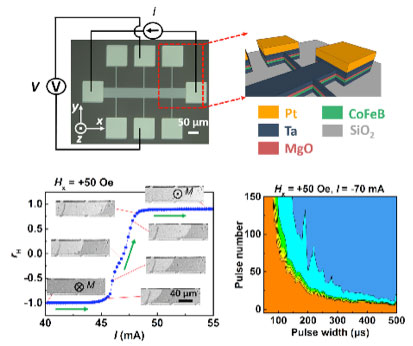| Jun 20, 2019 | |
A ferromagnetic memristor based on conventional magnetic memory(Nanowerk News) Researchers are proposing a spin–orbit-torque (SOT) memristive device based upon Ta/CoFeB/MgO heterostructures with perpendicular magnetic anisotropy (PMA). In this device, the magnetization and the anomalous Hall effect (AHE) resistance are modulated in an analog manner, associated with SOT-induced domain wall propagation in creep regime. |
|
| This Ta/CoFeB/MgO memristor device offers a practical structure for commercial perpendicular spin transfer torque magnetic random access memory (STT-MRAM), which pave the way towards the integration of high-density, energy-effcient components for non-volatile memory and neuromorphic computing applications. | |
| The research team is led by Long You, a professor at Nanoscale Energy Efficient Devices and Systems (NEEDS) Lab, Huazhong University of Science and Technology, Wuhan, China. This work has been published and the paper is selected for the back cover in a recent issue of Advanced Electronic Materials ("Memristors: A Spin–Orbit-Torque Memristive Device"). | |
 |
|
| In the proposed spin–orbit-torque memristive device based on Ta/CoFeB/MgO heterostructure, the magnetization and consequently the anomalous Hall effect resistance are modulated in an analog manner, being controlled by the pulsed current characteristics including amplitude, duration, and repetition number. (Image: Huazhong University of Science and Technology) | |
| Memristors, demonstrated by solid-state devices with continuously tunable resistance, have emerged as a new paradigm for self-adaptive networks that require synapse-like functions. Spin-based memristors offer advantages over other types of memristors because of their significant endurance and high energy effciency. | |
| However, it remains a challenge to build dense and functional spintronic memristors with structures and materials that are compatible with existing ferromagnetic devices. Ta/CoFeB/MgO heterostructures are commonly used in interfacial PMA-based magnetic tunnel junctions, which exhibit large tunnel magnetoresistance and are implemented in commercial MRAM products. | |
| “To achieve the memristive function, DW is driven back and forth in a continuous manner in the CoFeB layer by applying in-plane positive or negative current pulses along the Ta layer, utilizing SOT that the current exerts on the CoFeB magnetization,” said Shuai Zhang, a coauthor in the paper. “Slowly propagating domain wall generates a creep in the detection area of the device, which yields a broad range of intermediate resistive states in the AHE measurements. Consequently, AHE resistance is modulated in an analog manner, being controlled by the pulsed current characteristics including amplitude, duration, and repetition number.” | |
| “For a follow-up study, we are working on more neuromorphic operations, such as spike-timing-dependent plasticity and paired pulsed facilitation,” concludes You. “In parallel, we will fabricate the SOT memristor array for constructing spin-based energy-efficient neuromorphic systems.” |
| Source: Huazhong University of Science and Technology | |
|
Subscribe to a free copy of one of our daily Nanowerk Newsletter Email Digests with a compilation of all of the day's news. |
